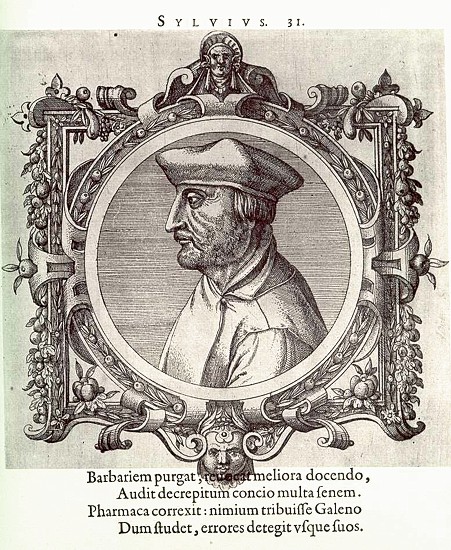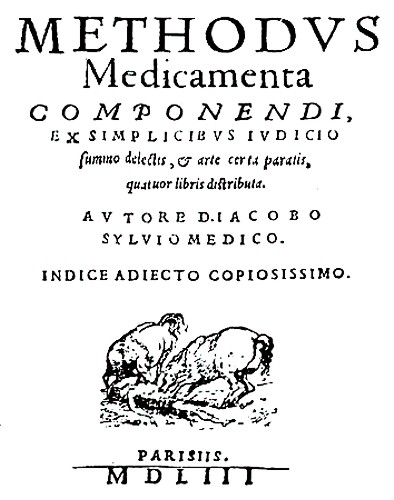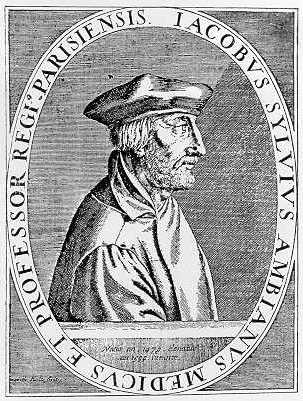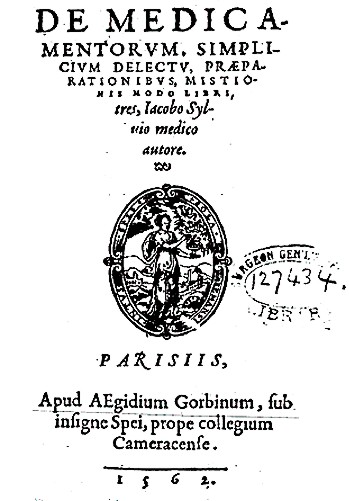Lessico
Sylvius
Jacques Dubois

Icones
veterum aliquot ac recentium Medicorum Philosophorumque
Ioannes Sambucus / János Zsámboky![]()
Antverpiae 1574
Anatomista e chirurgo francese noto anche col nome latinizzato di Sylvius (Amiens 1478 - Parigi 1555). Seguace delle teorie galeniche, fu tuttavia innovatore e propulsore degli studi anatomici in Francia. Scoprì le valvole venose della vena àzygos, vena che si origina nella cavità addominale; scorre nel torace lateralmente alla colonna vertebrale, raccogliendo il sangue refluo dalle vene intercostali, e sbocca nella cava superiore.
Il grande Andreas
Vesalius![]() , forma
italianizzata dell'anatomista fiammingo André van Wesele (Bruxelles
1514-Zante 1564), dopo i primi studi a Lovanio, fu a Parigi allievo di Jacques
Dubois.
, forma
italianizzata dell'anatomista fiammingo André van Wesele (Bruxelles
1514-Zante 1564), dopo i primi studi a Lovanio, fu a Parigi allievo di Jacques
Dubois.
Ecco alcune opre di Sylvius pubblicate da Gallica, alias Bibliothèque Nationale de France, un tesoro inesauribile presente nel web:
Commentarius in Claudii Galeni de ossibus ad tyrones libellum
Commentarius in Claudii Galeni duos libros de differentiis febrium
De medicamentorum simplicium delectu, praeparationibus, mistionis modo, libri tres
De mensibus mulierum, et hominis generatione
Iacobii Sylvii Ambiani in linguam gallicam isagoge
Methodus medicamenta componendi, ex simplicibus iudicio summo delectis, , et arte certa paratis
Victus ratio scolasticis pauperibus paratu facilis


Jacques Dubois (1478-1555), under the Latin name of Jacobus Sylvius, was an early exponent of the science of anatomy in France. He was fortunate in acquiring his reputation, since he did little original research. At the instance of his brother Francis, professor of eloquence in the college of Tournay at Paris, he devoted himself to the study of languages and mathematics; but feeling that the rewards were inadequate, Dubois abandoned them and went in for medicine.
After the acquisition of a medical degree in the university of Montpellier, at the ripe age of fifty-one Dubois returned to Paris to resume a course of anatomical instruction. Here he taught anatomy to a numerous audience in the college of Trinquet; and on the departure of Vidus Vidius for Italy was appointed to succeed him as professor of surgery to the Royal College.
His
manners and language were described as coarse even for the time. He was an
admirer of Galen![]() , and
interpreted the anatomical and physiological writings of that author in
preference to giving demonstrations from the subject. He showed signs of
jealousy towards those more learned than himself. Vesalius
, and
interpreted the anatomical and physiological writings of that author in
preference to giving demonstrations from the subject. He showed signs of
jealousy towards those more learned than himself. Vesalius![]() , who
was his pupil, states that his manner of teaching was calculated neither to
advance the science nor to rectify the mistakes of his predecessors.
, who
was his pupil, states that his manner of teaching was calculated neither to
advance the science nor to rectify the mistakes of his predecessors.
A human body was never seen in the theatre of Dubois; the carcasses of dogs and other animals were the materials from which he taught; and so difficult even was it to obtain human bones, that unless Vesalius and his fellow-students had collected assiduously from the Innocents and other cemeteries, they must have committed numerous errors in acquiring the first principles.
This assertion, however, is contradicted by J. Riolan, and afterwards by K. P. J. Sprengel and T. Lauth, the last of whom decidedly censures Vesalius for this ungrateful treatment of his instructor. It is certain that opportunities of inspecting the human body were by no means so frequent as to facilitate the study of the science. Though his mention of injections has led some to suppose him the discoverer of that art, he appears to have made no substantial addition to the information already acquired; and the first acknowledged professor of anatomy to the university of Paris appears in history as one who lived without true honour and died without just celebrity.
He must not be confounded with Franciscus Sylvius (de le Boe), who is mentioned by F. Ruysch and M. V. G. Malacarne as the author of a particular method of demonstrating the brain.

Dictionnaire
historique
de la médecine ancienne et moderne
par Nicolas François Joseph Eloy
Mons – 1778